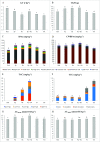Influence of Agronomic Practices on the Antioxidant Compounds of Pigmented Wheat (Triticum aestivum spp. aestivum L.) and Tritordeum (× Tritordeum martinii A. Pujadas, nothosp. nov.) Genotypes
- PMID: 37641979
- PMCID: PMC10510394
- DOI: 10.1021/acs.jafc.3c02592
Influence of Agronomic Practices on the Antioxidant Compounds of Pigmented Wheat (Triticum aestivum spp. aestivum L.) and Tritordeum (× Tritordeum martinii A. Pujadas, nothosp. nov.) Genotypes
Abstract
Twelve pigmented wheat genotypes, one tritordeum, and one common wheat were grown in three field experiments under varying nitrogen (N) fertilization rates to investigate the contributions of genotype, environment, and fertilization on the levels of phenolic acids, anthocyanins, carotenoids and antioxidant capacity of the grains. Soluble phenolic acids increased significantly (+16%) in the environment with high soil N content, while bound phenolic acids and anthocyanins decreased (-16 and -57%). N fertilization affected the agronomic and qualitative traits but had limited effects on some bioactive compounds (bound phenolic acids and anthocyanins). The greatest differences appeared among the color groups and within the same color types, with the black group showing the most anthocyanins and phenolic acids (34.4 and 1207 mg·kg-1) and the highest antioxidant capacity. Some of the cultivars could be promising for the development of innovative supply chains and the production of functional foods, as they showed good yield and quality performances, and good antioxidant features.
Keywords: Triticum aestivum; anthocyanins; antioxidant capacity; carotenoids; nitrogen; phenolic acids; pigmented cereals; technological quality; × Tritordeum martinii.
Conflict of interest statement
The authors declare no competing financial interest.
Figures



Similar articles
-
Distribution of bioactive compounds in pearled fractions of tritordeum.Food Chem. 2019 Dec 15;301:125228. doi: 10.1016/j.foodchem.2019.125228. Epub 2019 Jul 23. Food Chem. 2019. PMID: 31377613
-
Free and esterified carotenoids in pigmented wheat, tritordeum and barley grains.Food Chem. 2018 Feb 1;240:670-678. doi: 10.1016/j.foodchem.2017.07.151. Epub 2017 Jul 29. Food Chem. 2018. PMID: 28946328
-
5-n-Alkylresorcinol Profiles in Different Cultivars of Einkorn, Emmer, Spelt, Common Wheat, and Tritordeum.J Agric Food Chem. 2021 Dec 1;69(47):14092-14102. doi: 10.1021/acs.jafc.1c05451. Epub 2021 Nov 18. J Agric Food Chem. 2021. PMID: 34793147 Free PMC article.
-
Bioactive compounds, nutritional benefits and food applications of colored wheat: a comprehensive review.Crit Rev Food Sci Nutr. 2021;61(19):3197-3210. doi: 10.1080/10408398.2020.1793727. Epub 2020 Jul 20. Crit Rev Food Sci Nutr. 2021. PMID: 32686468 Review.
-
General Health Benefits and Pharmacological Activities of Triticum aestivum L.Molecules. 2022 Mar 17;27(6):1948. doi: 10.3390/molecules27061948. Molecules. 2022. PMID: 35335312 Free PMC article. Review.
References
-
- Lachman J.; Martinek P.; Kotíková Z.; Orsák M.; Šulc M. Genetics and chemistry of pigments in wheat grain – A review. J. Cereal Sci. 2017, 74, 145–154. 10.1016/j.jcs.2017.02.007. - DOI
-
- Leong H. Y.; Show P. L.; Lim M. H.; Ooi C. W.; Ling T. C. Natural red pigments from plants and their health benefits: A review. Food Rev. Int. 2018, 34, 463–482. 10.1080/87559129.2017.1326935. - DOI
MeSH terms
Substances
LinkOut - more resources
Full Text Sources
Medical
Miscellaneous

